We may earn revenue from the products available on this page and participate in affiliate programs. Learn More ›
The 300 Blackout rifle and cartridge were born out of a request by the U.S. Special Operations Command. While the 300 BLK saw limited use in the military, it’s been accepted widely by hunters and recreational shooters, particularly those targeting feral hogs. It shines in short-barreled rifles, and it offers the flexibility to shoot subsonic and supersonic rounds.
If you’re looking for a quiet, low-recoiling 300 BLK rifle for fun or hunting, I talked to two experts for their picks of the best 300 blackout rifles.
How I Chose the Best 300 Blackout Rifles
I talked to David Stark, the president of Discreet Ballistics who manufactures some of the best 300 Blackout ammunition available. His company specializes in subsonic hunting ammo and he’s an expert in understanding what makes for an accurate 300 BLK rifle. He’s also shot many of the most popular rifles chambered in the cartridge and has feedback from his customers on them. Start provided information on what to look for in a 300 BLK gun and offered suggestions of his favorite rifles.
I also talked to Kevin Brittingham (now with Q) who was on the team that designed the 300 Blackout. He’s hunted big game throughout North America and Africa with the 300 BLK and has designed two of the most popular rifles. Brittingham provided background on the 300 BLK, its history, and information on the ideal twist rate.
Best 300 Blackout Rifles: Recommendations
Best Overall: Q Honey Badger
See It
Key Features
- Price: $3,000
- Capacity: 10, 20, 30 standard AR-magazines
- Action: Semi-automatic
- Twist Rate: 1:5 inches
- Barrel Length: 7 inches
- Overall length: 20 to 25 inches
- Weight: 4.5 pounds
Pros
- Free-floating handguard
- Two-position collapsible PDW stock
- Adjustable gas block
- free floating m-lok handguard
- Compact
Cons
The Honey Badger is the Rolls Royce of 300 Blackout rifles. Its compact size allows for easy use in close quarters; it was custom-built for SOCOM’s low visibility assault weapon program. Like the Mini Fix SBR, the Honey Badger is an investment in a top-of-the-line 300 Blackout rifle.
It’s perfect for home defense or hunting. At only 4.5 pounds, the Honey Badger can be carried all day without hardly noticing it, unlike some of the heavier options available. It takes standard M4 magazines, so you won’t have to worry about specific brands that will fit the rifle’s magwell.
The Honey Badger’s fast twist rate is ideal for stabilizing heavy bullets and provides rotational energy that allows subsonic expanding bullets to open more easily (more info on that later).
Read Next: Banish Backcountry Suppressor Review
Best Budget: CVA Scout V2 Stainless Single Shot Rifle – 300 AAC Blackout
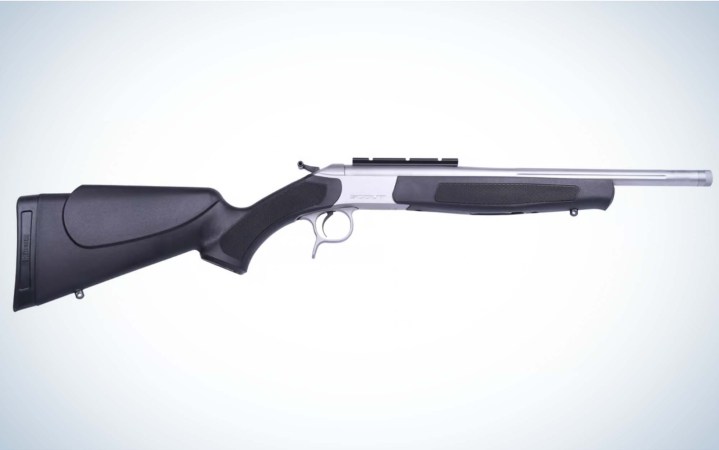
See It
Key Features
- Price: $400
- Capacity: 1
- Break action
- Twist Rate: 1:8 inches
- Barrel Length: 16.5 inches
- Overall length: 38 inches
- Weight: 5.8 pounds
Pros
- Budget-friendly
- Ambidextrous stock
- Beginner user friendly
- Quick, toolless takedown
Cons
- Non-adjustable trigger
- Spent cartridges don’t eject
The CVA Scout V2 300 Blackout is the rifle to go for if you are interested in the cartridge but don’t want to spend a lot to try it out. It’s an affordable rifle with a crisp 3-pound trigger pull with no creep. That trigger can be great if you’re used to a lighter trigger pull, but it’s something to be aware of when picking out the rifle you want.
Its ambidextrous stock and break action make it suitable for right or left-handed shooters. Chambered in the low-recoiling 300 Blackout, the Scout V2 is a great gun for beginners.
The 1:8-inch twist rate may result in less precise groups if you are using heavy 190 to 220-grain subsonic bullets, but it will work well when shooting supersonic ammunition. The slower twist can cause subsonic rounds to yaw at the point of impact. It’s not tumbling, but it can affect the bullet’s accuracy and effectiveness.
Stark said that subsonic rounds through the CVA should be exclusively used for shots at 50 yards or less. The CVA Scout V2 comes threaded for a silencer or flash suppressor. The best part about this rifle is the quality of the rifle build, combined with the affordable price and lifetime warranty.
Best for Hunting: Ruger American Ranch Rifle
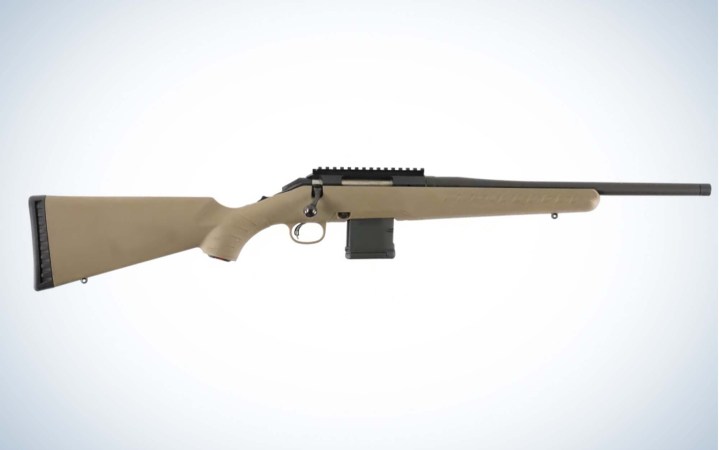
See It
Key Features
- Price: $550
- Capacity: 10
- Bolt action
- 70-degree bolt lift
- Twist Rate: 1:7 inches
- Barrel Length: 16.12 inches
- Overall length: 36 inches
- Weight: 5.9 pounds
Pros
- Adjustable trigger
- Magazine fed
- Comes threaded ⅝ inch-24
- Includes drilled and tapped with Picatinny rail
Cons
The Ruger American Ranch Rifle is an affordable and accurate rifle (see Tyler Freel’s 350 Legend rifles test for a look at its accuracy). This rifle is another great option for beginners but is a smart choice for more experienced hunters, too. Stark said this is a popular option for people who hunt with the 300 BLK. So much so that he makes Ruger American optimized 300 BLK ammo.
The adjustable trigger offers a range of 3 to 5 pounds. The soft recoil pad isn’t ideal for a firm shoulder connection and is not needed for the 300 BLK’s low recoil. But you can buy an aftermarket recoil pad and have it installed. You can take the customization a step further by replacing the entire stock with one of the many options for the Ruger American.
The smooth single-piece, three-lug bolt has a 70-degree throw arm, which grants plenty of scope clearance. The full-diameter bolt body combined with dual cocking cams provides a smooth, easy cycling of the bolt from any stance.
Read Next: Best Thermal Scopes
Best for Home Defense: Noveske Chainsaw SBR
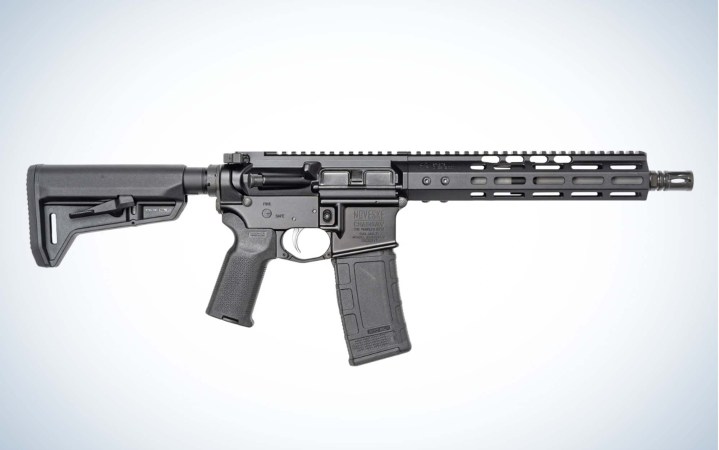
See It
Key Features
- Price: $1,800
- Capacity: Comes with standard 30-round magazine, but they can be substituted with 10-round magazines
- Semi automatic
- Twist Rate: 1:7 inches
- Barrel Length: 7.94 or 10.5 inches
- Overall length: 24 inches with fully collapsed stock
- Weight: 5.4 pounds
Pros
- H1 buffer and carbine action spring for better recoil management
- Free floating M-LOK handguard
- Quality gas block
- Compact
Cons
- Heavier than other options on the market
- ATF Form 1 and $200 tax payment required for the short-barreled rifle version
The Noveske Chainsaw SBR’s compact design and quality gas block make this an affordable but high-quality option for home defense.
If you don’t like the sub-8-inch barrel, you can always order the setup with the 10.5-inch barrel. Of course, both barrel options would require a $200 tax and an approved ATF form 1. If you already have an SBR lower, you can get the Chainsaw as an upper only. Another option is to buy the Chainsaw as a pistol.
The ambidextrous Radian Raptor LT charging handle is a nice touch, along with the M-LOK handguard and a Picatinny 1913 top rail.
Best Ultralight: Q Mini Fix
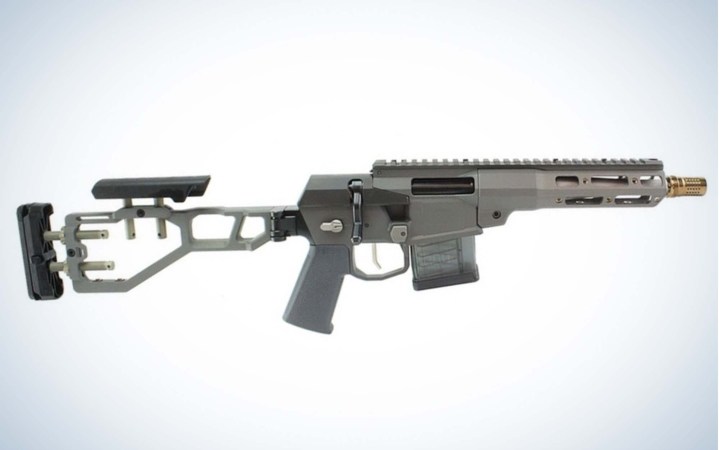
See It
Key Features
- Price: $3,000
- Capacity: 10, 20, 30 rounds
- Uses AR magazines
- Bolt action
- Twist Rate: 1:5 inches
- Barrel Length: 8 inches
- Overall length: 26.9 inches collapsed stock; 28.1 inches full extension
- Weight: 4.4 pounds
Pros
- Designed specifically for the 300 blackout
- Tapered barrel
- 45-degree bolt is smooth and user-friendly
- Light and compact; stock folds down
- Highly modular
- Free-floating handguard
- Integral silencer
Cons
- Expensive
- Cannot shoot with stock folded
Like the Noveske Chainsaw, this rifle is an NFA item, but this fully custom-made rifle is accurate, and Brittingham has used it for hunting shots beyond 300 meters with subsonics. Brittingham and Stark cautioned customers to understand that anything beyond 100 meters requires an understanding of ballistics. Consider that out of a 16-inch barrel the Hornady 190-grain Sub-X load has a 1.5-inch point of impact shift between the muzzle and 100 yards. Then it drops 33 inches between 100 and 200 yards and drops 104 inches between 200 and 300 yards. So you better know your exact distance and DOPE to make shots beyond 100.
The compact and lightweight Mini Fix is ideal for carrying all day. You can fold the stock down, and it fits into just about any backpack. It’s ready for any suppressor, which you will want because 300 BLK is fantastic suppressed. If the Chainsaw is the hammer, the Mini Fix SBR is the scalpel. Stark and Brittingham described this rifle as a tack driver that can perform in all conditions.
It’s expensive, and if you are simply looking for a beater rifle to check out the 300 Blackout experience, there are several other options available that can fit your needs. But if you are looking for an accurate rifle that gets the most out of the cartridge, this is one of the best 300 Blackout rifles available.
Origin of the 300 Blackout
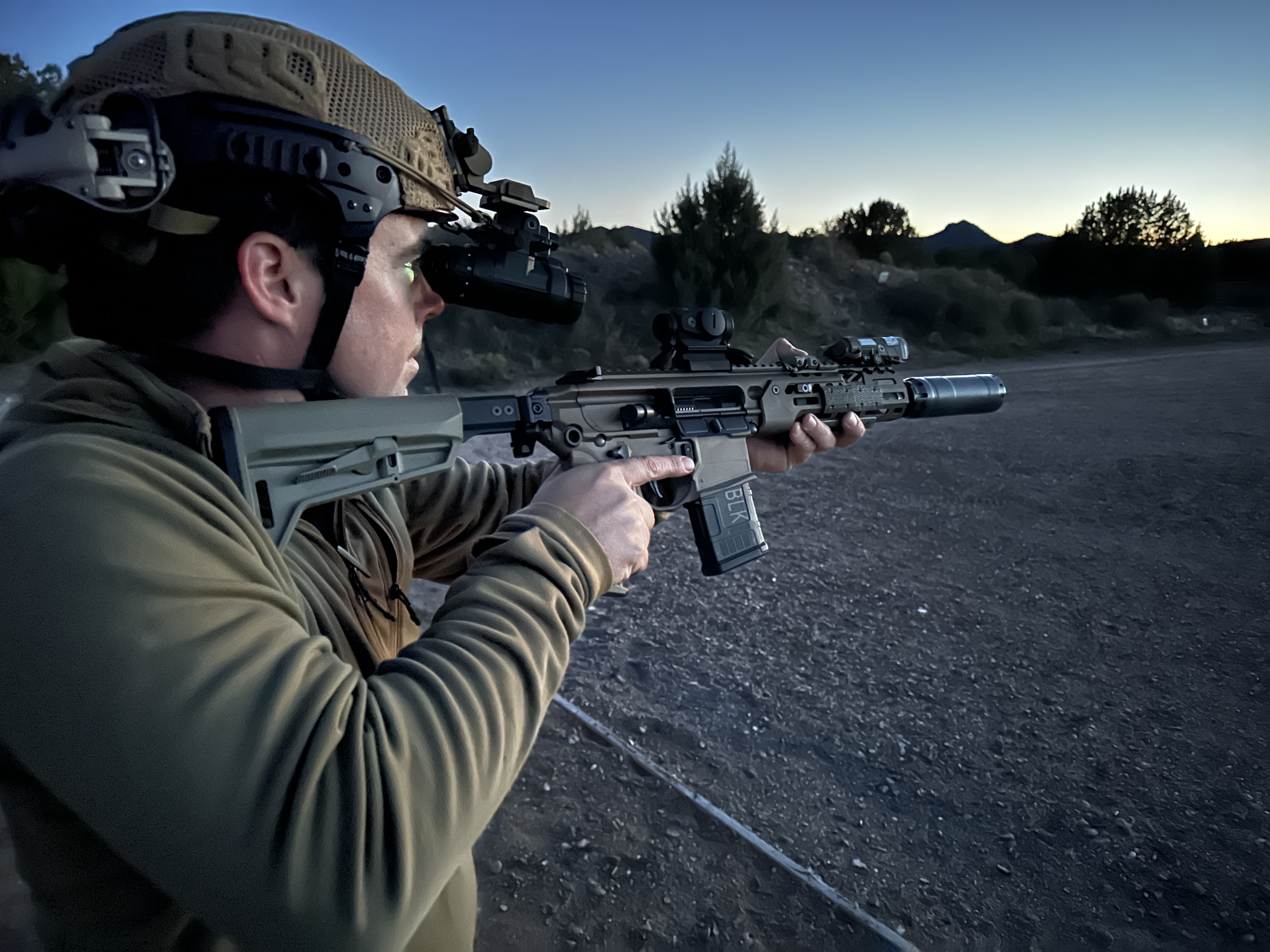
Scott Einsmann
The request came in 2011 after SOCOM had purchased around 20, .300 Whisper rifles. The personnel testing them ran into reliability issues with most of them. The .300 Whisper uses a .308 bullet, and the ogive led to problems with the feed ramp and the AR magazines.
But, the soldiers with the non-problematic rifles didn’t want to turn them in when their command decided to move away from them. SOCOM approached Brittingham for a solution.
Brittingham, who was in the process of selling AAC to Remington, tested the 300 Whisper and found it to be unreliable.
“So we kind of worked out that it just needed longer bullets in a different shape that basically were a little more slender where it contacted the rib in the magazine in order to be reliable,” says Brittingham.
Brittingham asked Remington if they’d manufacture his 300 Blackout round. They reluctantly agreed, but only if he could get a military contract for the ammunition. He and his team went to work developing a round in the basement of one of his engineer’s homes.
After investing countless hours into research and development, the team succeeded in creating a reliable and effective 300 Blackout cartridge. Their success was validated when Brittingham received an order for a million rounds from the U.S. Navy Special Warfare Development Group.
Soon after, they started delivering the uppers to various SOF units.
“We delivered complete uppers in 9 and 12-inch and later complete rifles in 300 Blackout, and we delivered subsonic and supersonic ammo,” says Brittingham. “Soon after, we developed the Barnes 110. One of the best self-defense or hunting projectiles ever developed.”
Almost a year later, Brittingham and Remington had a falling out, and the project fizzled. Brittingham has experienced ups and downs in his business venture with Sig Sauer and Remington but kept going.
Several ammo companies told Brittingham the round wouldn’t work or that it would only be applicable for military use. He proved them wrong, and it’s now a widely used round for everything from hunting to self-defense. Brittingham’s Q, LLC. is now one of the leading experts in 300 Blackout and the new 8.6 Blackout.
300 Blackout Twist Rates
The twist rate is a major component of what establishes accuracy for a firearm, though there are other factors to account for when you get into precision shooting. The twist rate is a crucial component in stabilizing the bullet in flight. The wrong twist rate can cause inaccurate shots, early bullet expansion, or bullets to tumble.
When Brittingham and his team were developing the 300 Blackout, they worked on improving the accuracy dispersion at subsonic speeds with a short barrel. He started with a 9-inch barrel and a 1-in-7 twist rate.
The team found they could shorten the barrel, give it a faster twist rate, and still achieve the same performance as their 9-inch barrels. That cutdown made the Honey Badger a lighter, quieter, and harder-hitting rifle in a compact package, making it an effective close-quarters home defense rifle.
Brittingham and his team started chasing subsonic accuracy dispersion via faster twist rates. But they had to stop shy of what Brittingham is currently implementing with his latest 8.6 Blackout rifles, using a 1:3-inch twist rate.
“SOCOM adopted a subsonic, barrier-blind projectile during this time, and so we had to stop at 1 in 5 because of the projectile they adopted,” Brittingham says. “When we went to 1:4 inch it expanded out of the muzzle at subsonic linear velocity, so we stopped there.”
The original SOCOM request was a silencer-friendly rifle and ammunition that can perform at subsonic speeds. The Honey Badger answered that need, though the deal fell apart. The military ended up adopting the Sig Sauer Rattler. Brittingham and Stark agreed that a 1:5-inch twist rate is the best for 300 Blackout with either super or subsonic bullets.
But, Stark warned that mass-produced commercial ammunition may come with flaws, and a fast twist rate like 1:5-inch will reveal any imperfections via early expansion of the bullet in the barrel, exiting the barrel, or before impact. Early expansion is bad for accuracy and effective kill shots while hunting.
Barrel length isn’t as much of an issue in fast twist rates, whereas a slower twist rate will require a longer barrel so it can stabilize the bullet. Without that long barrel, the accuracy dispersion would be awful while shooting subs and not ideal for supers.
Stark said 300 Blackout twist rates range from 1:8-inch to 1:5-inch. A bullet traveling at 1,000 feet per second is spinning at 90,000 rpm. A 1:5-inch twist sends a bullet spinning at 144,000 rpm. That results in a Delta of 54,000 rpm, which means the bullet spins more as it expands in the animal.
“So that’s, that’s kind of a free lunch in the sense of both bullets are hitting at the same velocity, but one’s doing more damage as a result of spinning rotationally in addition to the linear kinetic energy,” says Stark.
300 Blackout is an excellent round for close-range shooting but not so much for longer distances. Stark explained that he’s seen special operations soldiers running magazines of subsonic and supersonic rounds in their kit, something you can do while hunting.
Subsonic works great for up to 300 meters, though you may have to hold pretty high to get the bullet on target. Brittingham said the subsonic rounds are great because they don’t lose substantial speed after leaving the barrel. You just need to get the bullet on target. That can be tricky with subsonic rounds at a distance.
To effectively shoot further out, you will want to use supersonic rounds.
“With supersonic rounds, you’re relying totally on the linear velocity for bullet performance. When you do something hyper-fast, you’re not relying on linear velocity,” says Brittingham. “The rotational velocity will provide you with better penetration, it will shoot flatter, and the bullets expand more reliably. So there’s lots of benefits.”
Final Thoughts
The difference between the Noveske Chainsaw SBR, Q Honey Badger, Ruger American Ranch rifle, and Mini Fix boils down to their features. The Ruger American is a great hunting rifle option, but if you want a rifle designed around the 300 BLK the Mini Fix is excellent and has the price to match. Choose the rifle that best matches your needs and budget, but don’t forget to pick up a suppressor to go with your new rifle to get the most out of the 300 Blackout.
Read the full article here




